Wastewater Treatment: Activated Sludge Process Lab Report
VerifiedAdded on 2020/04/07
|6
|803
|44
Report
AI Summary
This lab report details an experiment on wastewater treatment, focusing on the activated sludge process. The objective was to understand and illustrate wastewater quality enhancement through synthetic wastewater lab tests. The report covers the three conventional stages of wastewater treatment: primary, secondary (activated sludge process), and tertiary treatments. The procedure involved creating synthetic wastewater, mixing it with biomass, and measuring parameters such as Dissolved Oxygen (DO), carbon removal, and Dissolved Organic Carbon (DOC) levels over time. Data and results are presented in a table and graph, demonstrating carbon removal during the treatment process. The conclusion highlights the importance of the experiment in understanding the activated sludge process and suggests improvements for future experiments. References to scientific literature on wastewater treatment are included.
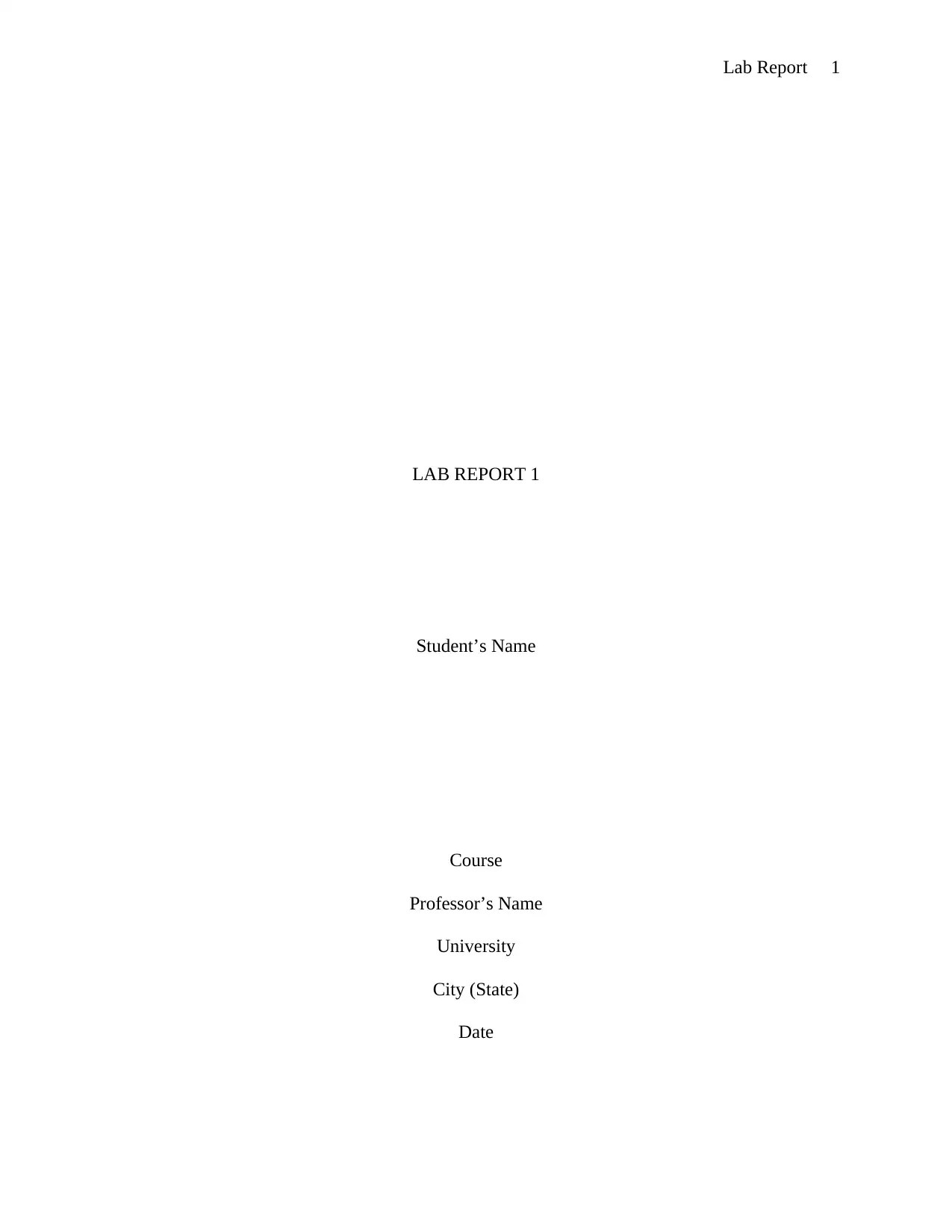
Lab Report 1
LAB REPORT 1
Student’s Name
Course
Professor’s Name
University
City (State)
Date
LAB REPORT 1
Student’s Name
Course
Professor’s Name
University
City (State)
Date
Paraphrase This Document
Need a fresh take? Get an instant paraphrase of this document with our AI Paraphraser
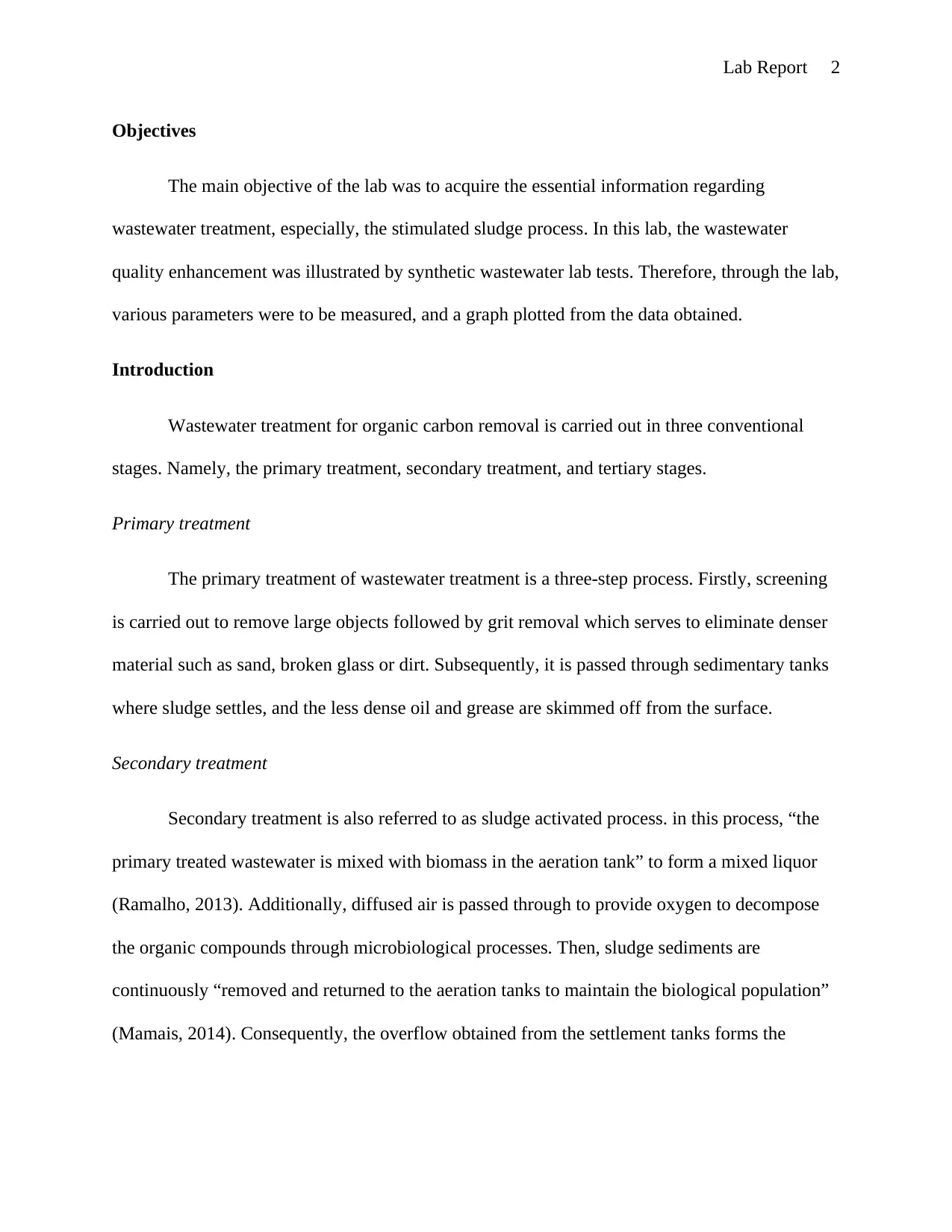
Lab Report 2
Objectives
The main objective of the lab was to acquire the essential information regarding
wastewater treatment, especially, the stimulated sludge process. In this lab, the wastewater
quality enhancement was illustrated by synthetic wastewater lab tests. Therefore, through the lab,
various parameters were to be measured, and a graph plotted from the data obtained.
Introduction
Wastewater treatment for organic carbon removal is carried out in three conventional
stages. Namely, the primary treatment, secondary treatment, and tertiary stages.
Primary treatment
The primary treatment of wastewater treatment is a three-step process. Firstly, screening
is carried out to remove large objects followed by grit removal which serves to eliminate denser
material such as sand, broken glass or dirt. Subsequently, it is passed through sedimentary tanks
where sludge settles, and the less dense oil and grease are skimmed off from the surface.
Secondary treatment
Secondary treatment is also referred to as sludge activated process. in this process, “the
primary treated wastewater is mixed with biomass in the aeration tank” to form a mixed liquor
(Ramalho, 2013). Additionally, diffused air is passed through to provide oxygen to decompose
the organic compounds through microbiological processes. Then, sludge sediments are
continuously “removed and returned to the aeration tanks to maintain the biological population”
(Mamais, 2014). Consequently, the overflow obtained from the settlement tanks forms the
Objectives
The main objective of the lab was to acquire the essential information regarding
wastewater treatment, especially, the stimulated sludge process. In this lab, the wastewater
quality enhancement was illustrated by synthetic wastewater lab tests. Therefore, through the lab,
various parameters were to be measured, and a graph plotted from the data obtained.
Introduction
Wastewater treatment for organic carbon removal is carried out in three conventional
stages. Namely, the primary treatment, secondary treatment, and tertiary stages.
Primary treatment
The primary treatment of wastewater treatment is a three-step process. Firstly, screening
is carried out to remove large objects followed by grit removal which serves to eliminate denser
material such as sand, broken glass or dirt. Subsequently, it is passed through sedimentary tanks
where sludge settles, and the less dense oil and grease are skimmed off from the surface.
Secondary treatment
Secondary treatment is also referred to as sludge activated process. in this process, “the
primary treated wastewater is mixed with biomass in the aeration tank” to form a mixed liquor
(Ramalho, 2013). Additionally, diffused air is passed through to provide oxygen to decompose
the organic compounds through microbiological processes. Then, sludge sediments are
continuously “removed and returned to the aeration tanks to maintain the biological population”
(Mamais, 2014). Consequently, the overflow obtained from the settlement tanks forms the
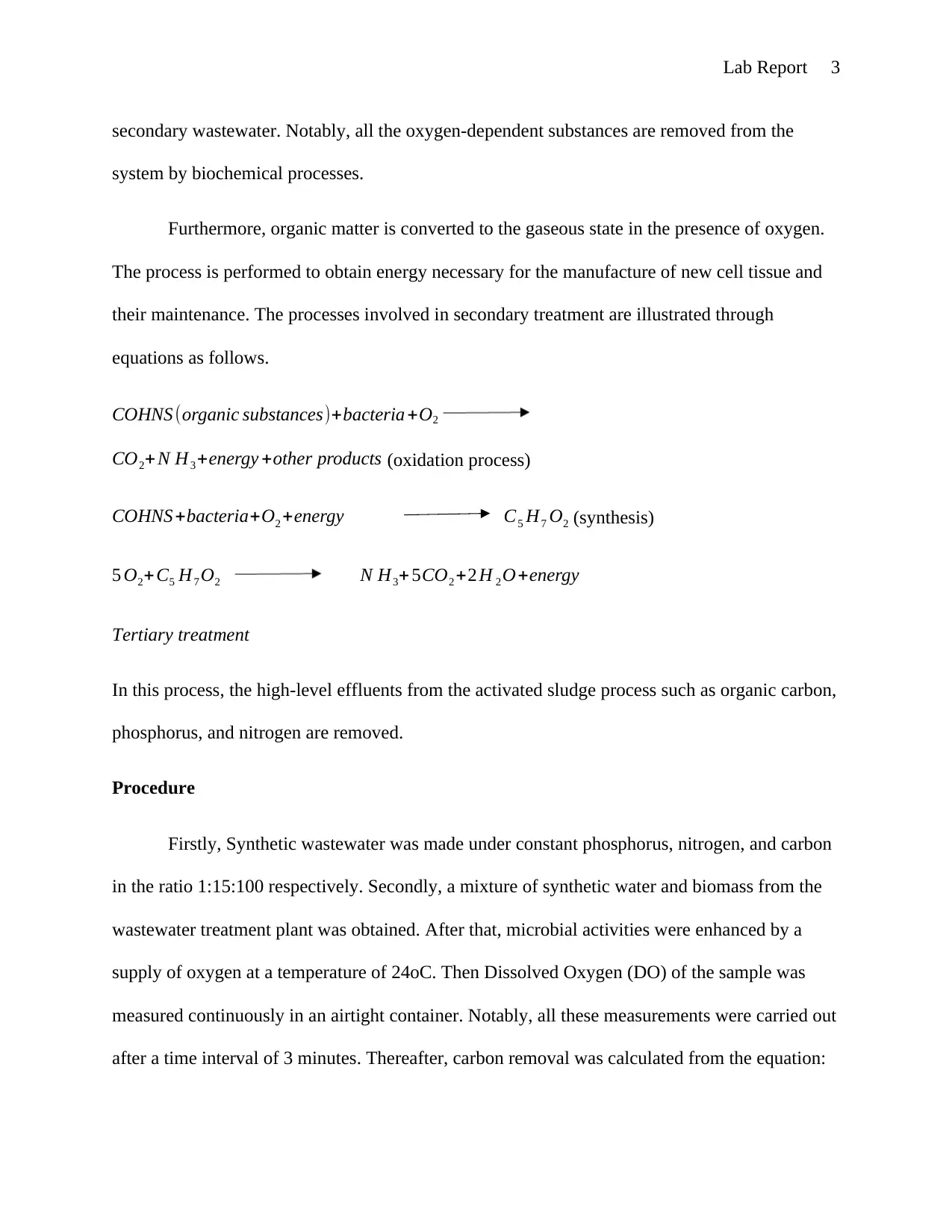
Lab Report 3
secondary wastewater. Notably, all the oxygen-dependent substances are removed from the
system by biochemical processes.
Furthermore, organic matter is converted to the gaseous state in the presence of oxygen.
The process is performed to obtain energy necessary for the manufacture of new cell tissue and
their maintenance. The processes involved in secondary treatment are illustrated through
equations as follows.
COHNS (organic substances)+bacteria +O2
CO2+ N H3 +energy +other products (oxidation process)
COHNS +bacteria+O2 +energy C5 H7 O2 (synthesis)
5 O2+C5 H7 O2 N H3+ 5CO2 +2 H 2 O+energy
Tertiary treatment
In this process, the high-level effluents from the activated sludge process such as organic carbon,
phosphorus, and nitrogen are removed.
Procedure
Firstly, Synthetic wastewater was made under constant phosphorus, nitrogen, and carbon
in the ratio 1:15:100 respectively. Secondly, a mixture of synthetic water and biomass from the
wastewater treatment plant was obtained. After that, microbial activities were enhanced by a
supply of oxygen at a temperature of 24oC. Then Dissolved Oxygen (DO) of the sample was
measured continuously in an airtight container. Notably, all these measurements were carried out
after a time interval of 3 minutes. Thereafter, carbon removal was calculated from the equation:
secondary wastewater. Notably, all the oxygen-dependent substances are removed from the
system by biochemical processes.
Furthermore, organic matter is converted to the gaseous state in the presence of oxygen.
The process is performed to obtain energy necessary for the manufacture of new cell tissue and
their maintenance. The processes involved in secondary treatment are illustrated through
equations as follows.
COHNS (organic substances)+bacteria +O2
CO2+ N H3 +energy +other products (oxidation process)
COHNS +bacteria+O2 +energy C5 H7 O2 (synthesis)
5 O2+C5 H7 O2 N H3+ 5CO2 +2 H 2 O+energy
Tertiary treatment
In this process, the high-level effluents from the activated sludge process such as organic carbon,
phosphorus, and nitrogen are removed.
Procedure
Firstly, Synthetic wastewater was made under constant phosphorus, nitrogen, and carbon
in the ratio 1:15:100 respectively. Secondly, a mixture of synthetic water and biomass from the
wastewater treatment plant was obtained. After that, microbial activities were enhanced by a
supply of oxygen at a temperature of 24oC. Then Dissolved Oxygen (DO) of the sample was
measured continuously in an airtight container. Notably, all these measurements were carried out
after a time interval of 3 minutes. Thereafter, carbon removal was calculated from the equation:
⊘ This is a preview!⊘
Do you want full access?
Subscribe today to unlock all pages.

Trusted by 1+ million students worldwide
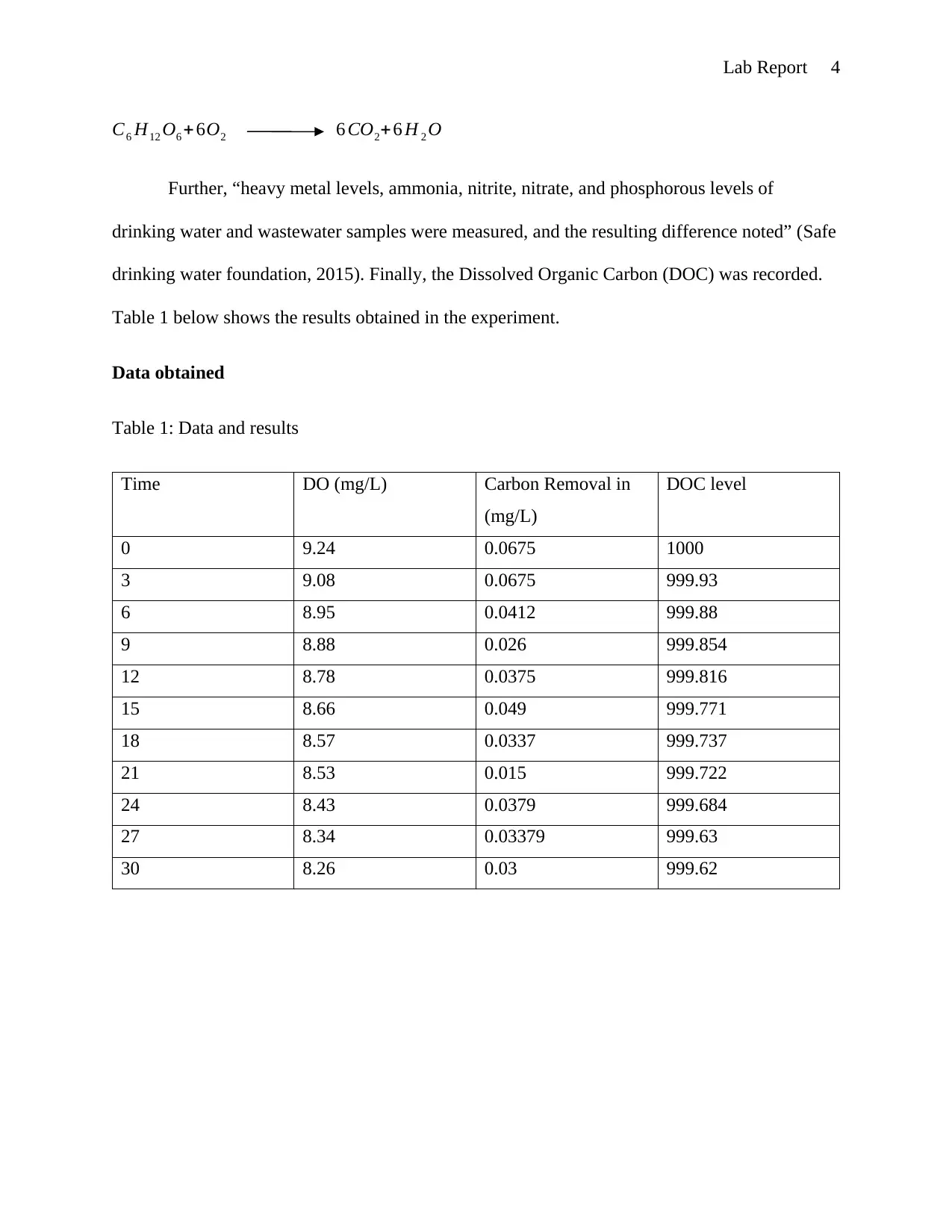
Lab Report 4
C6 H12 O6 +6O2 6 CO2+ 6 H 2 O
Further, “heavy metal levels, ammonia, nitrite, nitrate, and phosphorous levels of
drinking water and wastewater samples were measured, and the resulting difference noted” (Safe
drinking water foundation, 2015). Finally, the Dissolved Organic Carbon (DOC) was recorded.
Table 1 below shows the results obtained in the experiment.
Data obtained
Table 1: Data and results
Time DO (mg/L) Carbon Removal in
(mg/L)
DOC level
0 9.24 0.0675 1000
3 9.08 0.0675 999.93
6 8.95 0.0412 999.88
9 8.88 0.026 999.854
12 8.78 0.0375 999.816
15 8.66 0.049 999.771
18 8.57 0.0337 999.737
21 8.53 0.015 999.722
24 8.43 0.0379 999.684
27 8.34 0.03379 999.63
30 8.26 0.03 999.62
C6 H12 O6 +6O2 6 CO2+ 6 H 2 O
Further, “heavy metal levels, ammonia, nitrite, nitrate, and phosphorous levels of
drinking water and wastewater samples were measured, and the resulting difference noted” (Safe
drinking water foundation, 2015). Finally, the Dissolved Organic Carbon (DOC) was recorded.
Table 1 below shows the results obtained in the experiment.
Data obtained
Table 1: Data and results
Time DO (mg/L) Carbon Removal in
(mg/L)
DOC level
0 9.24 0.0675 1000
3 9.08 0.0675 999.93
6 8.95 0.0412 999.88
9 8.88 0.026 999.854
12 8.78 0.0375 999.816
15 8.66 0.049 999.771
18 8.57 0.0337 999.737
21 8.53 0.015 999.722
24 8.43 0.0379 999.684
27 8.34 0.03379 999.63
30 8.26 0.03 999.62
Paraphrase This Document
Need a fresh take? Get an instant paraphrase of this document with our AI Paraphraser
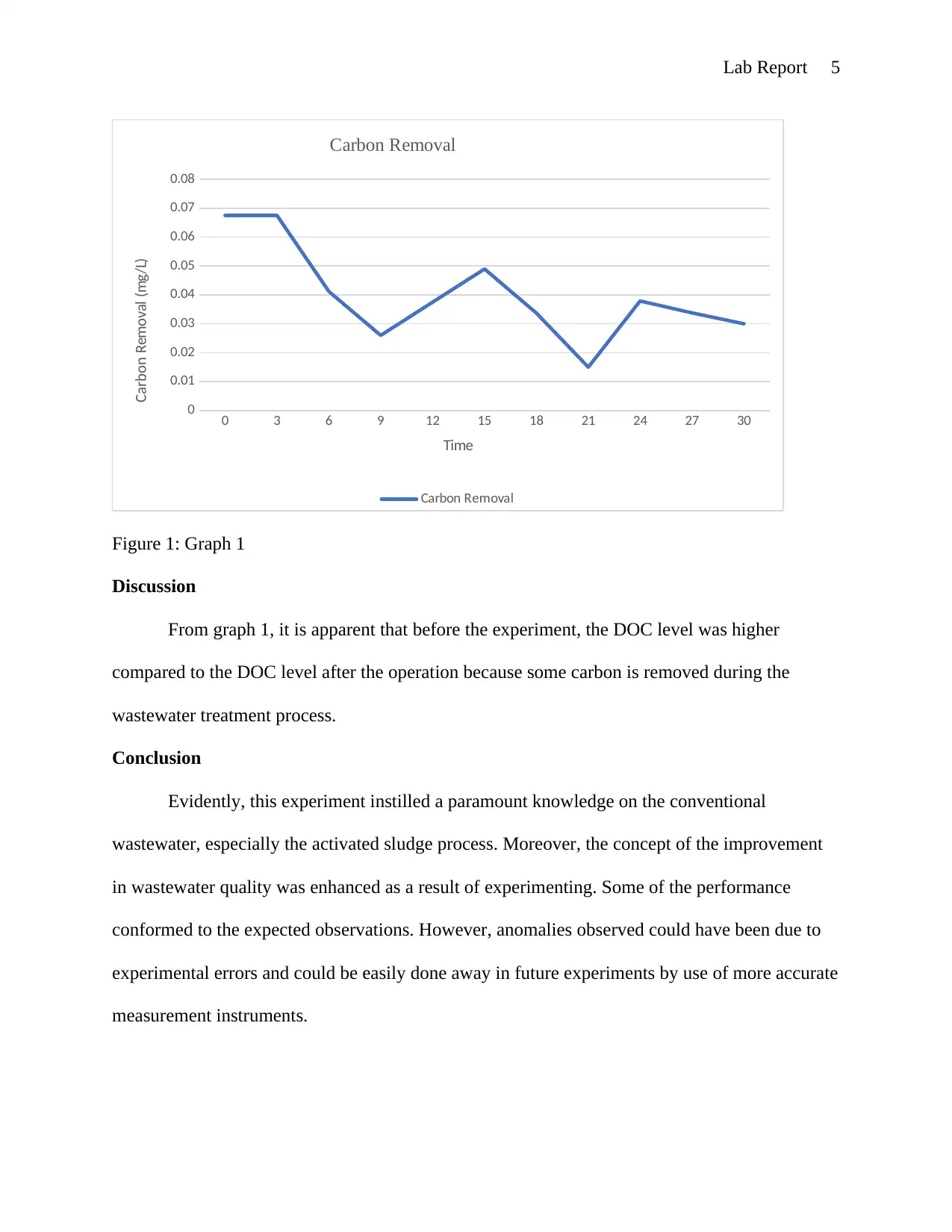
Lab Report 5
0 3 6 9 12 15 18 21 24 27 30
0
0.01
0.02
0.03
0.04
0.05
0.06
0.07
0.08
Carbon Removal
Carbon Removal
Time
Carbon Removal (mg/L)
Figure 1: Graph 1
Discussion
From graph 1, it is apparent that before the experiment, the DOC level was higher
compared to the DOC level after the operation because some carbon is removed during the
wastewater treatment process.
Conclusion
Evidently, this experiment instilled a paramount knowledge on the conventional
wastewater, especially the activated sludge process. Moreover, the concept of the improvement
in wastewater quality was enhanced as a result of experimenting. Some of the performance
conformed to the expected observations. However, anomalies observed could have been due to
experimental errors and could be easily done away in future experiments by use of more accurate
measurement instruments.
0 3 6 9 12 15 18 21 24 27 30
0
0.01
0.02
0.03
0.04
0.05
0.06
0.07
0.08
Carbon Removal
Carbon Removal
Time
Carbon Removal (mg/L)
Figure 1: Graph 1
Discussion
From graph 1, it is apparent that before the experiment, the DOC level was higher
compared to the DOC level after the operation because some carbon is removed during the
wastewater treatment process.
Conclusion
Evidently, this experiment instilled a paramount knowledge on the conventional
wastewater, especially the activated sludge process. Moreover, the concept of the improvement
in wastewater quality was enhanced as a result of experimenting. Some of the performance
conformed to the expected observations. However, anomalies observed could have been due to
experimental errors and could be easily done away in future experiments by use of more accurate
measurement instruments.
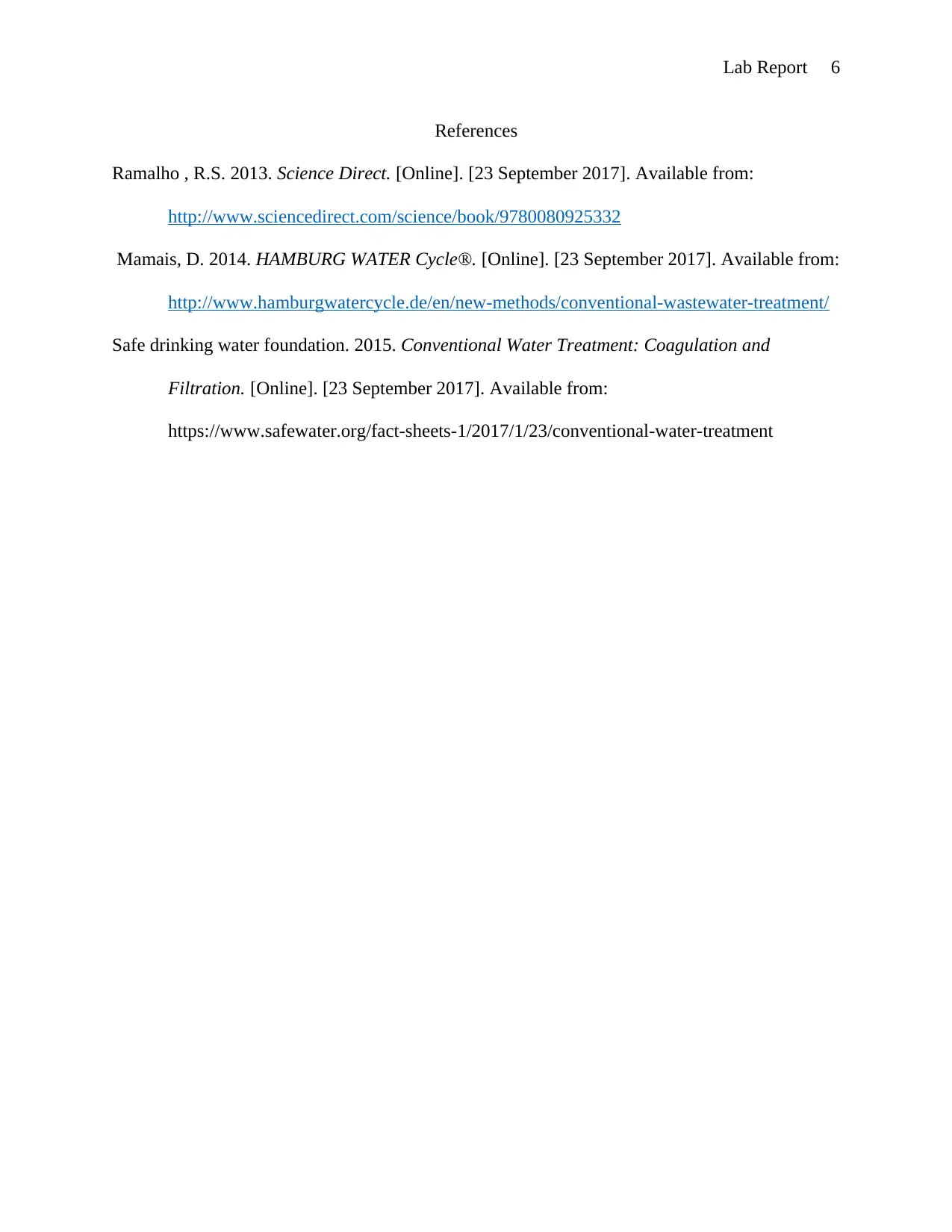
Lab Report 6
References
Ramalho , R.S. 2013. Science Direct. [Online]. [23 September 2017]. Available from:
http://www.sciencedirect.com/science/book/9780080925332
Mamais, D. 2014. HAMBURG WATER Cycle®. [Online]. [23 September 2017]. Available from:
http://www.hamburgwatercycle.de/en/new-methods/conventional-wastewater-treatment/
Safe drinking water foundation. 2015. Conventional Water Treatment: Coagulation and
Filtration. [Online]. [23 September 2017]. Available from:
https://www.safewater.org/fact-sheets-1/2017/1/23/conventional-water-treatment
References
Ramalho , R.S. 2013. Science Direct. [Online]. [23 September 2017]. Available from:
http://www.sciencedirect.com/science/book/9780080925332
Mamais, D. 2014. HAMBURG WATER Cycle®. [Online]. [23 September 2017]. Available from:
http://www.hamburgwatercycle.de/en/new-methods/conventional-wastewater-treatment/
Safe drinking water foundation. 2015. Conventional Water Treatment: Coagulation and
Filtration. [Online]. [23 September 2017]. Available from:
https://www.safewater.org/fact-sheets-1/2017/1/23/conventional-water-treatment
⊘ This is a preview!⊘
Do you want full access?
Subscribe today to unlock all pages.

Trusted by 1+ million students worldwide
1 out of 6
Related Documents
Your All-in-One AI-Powered Toolkit for Academic Success.
+13062052269
info@desklib.com
Available 24*7 on WhatsApp / Email
![[object Object]](/_next/static/media/star-bottom.7253800d.svg)
Unlock your academic potential
Copyright © 2020–2025 A2Z Services. All Rights Reserved. Developed and managed by ZUCOL.





